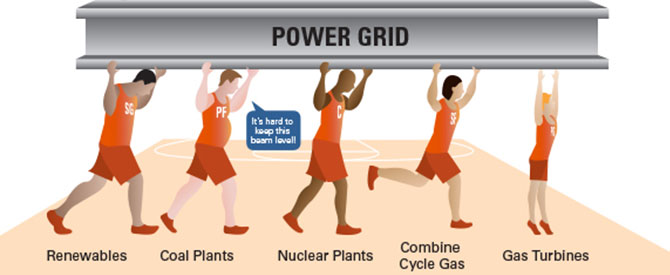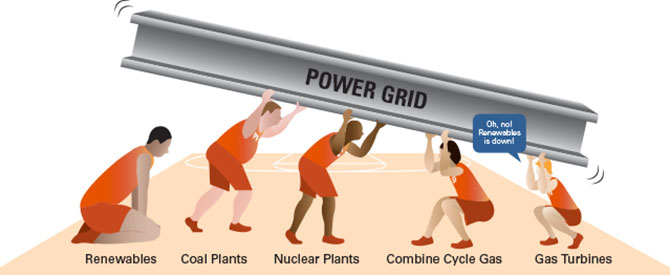I was recently on a flight when the woman sitting next to me asked what I did for a living. How do I explain my job to someone from the ground up? The reality is that I get this question frequently, so I've developed an elevator pitch, if you will, to explain the power industry. I've found that people generally want to know what the term "power grid" really means, or what "renewables" mean for them and their seemingly high electric bill.
How the Power Industry is like Basketball
In an effort to break down the complexities of the power industry and its accompanying terms, here's an analogy to explain coal and nuclear plants, combine cycle gas, gas turbines, and renewables. Imagine a basketball team training for the upcoming season. The coach tasks them with holding a steel beam (power) above their heads while running back and forth across the gym to get in shape. The shooting guard (renewables) hits an off-season growth spurt and continues to grow, but is clumsy because of his new, tall frame. The power forward (coal plants) is tall and strong but out of shape. The center (nuclear plants) is very tall, but doesn't run the court well due to his slow pace. The small forward (combine cycle gas) is a fairly average height but growing steadily and known for being smooth and athletic. Right now, the small forward (combine cycle gas) is the coach's favorite player. The point guard (gas turbines) is fast and agile, but significantly shorter than the rest of the team.

Now imagine the steel beam that they're running across the court, the team has to get it back and forth while keeping it level and without dropping it (loss of power). Grid stability is represented by the motion of the beam—up, down, forward, backward. Keeping the beam level has always been a challenge managed by balancing authorities or utility companies. Recent evolutions, such as the buildout of renewables, has increased the challenge and may ultimately lead to the need for fundamental changes in the power industry. However, right now, it's too soon to determine what these changes may look like.
Back to basketball, the shooting guard (renewables) is getting taller by the day, therefore carrying a larger and larger load. The issue is that he's still not used to his much taller body and is prone to tripping and falling. Because of this, the rest of the team must react quickly to make sure the steel beam doesn't bounce around or drop to the floor. The beam bouncing around represents brownouts, while the beam dropping altogether represents a blackout. The front court, comprised of the power forward (coal plants) and center (nuclear plants), must have quick reaction times, but this is restricted due to their limited agility. The small forward (combine cycle gas) and point guard (gas turbines) can do their part because they're agile, but their reactions need to be immediate in order to keep the beam elevated and level. The taller the shooting guard (renewables) gets, the quicker the small forward (combine cycle gas) and point guard (gas turbines) need to respond.

An Industry to be Analyzed
As long as the coach continues to analyze the players and help them learn to work together, the team has the ability to improve significantly. This is analogous to power providers and independent system operators preparing for rapidly changing conditions, like renewable penetration. The power industry has changed drastically over the last 10-12 years, and as it continues to do so, I look forward to the opportunities that lie ahead. What excites me most about these changes are the ways in which we can help our clients achieve the outcome they're looking for while continuing to develop new and innovative ways to meet those goals.